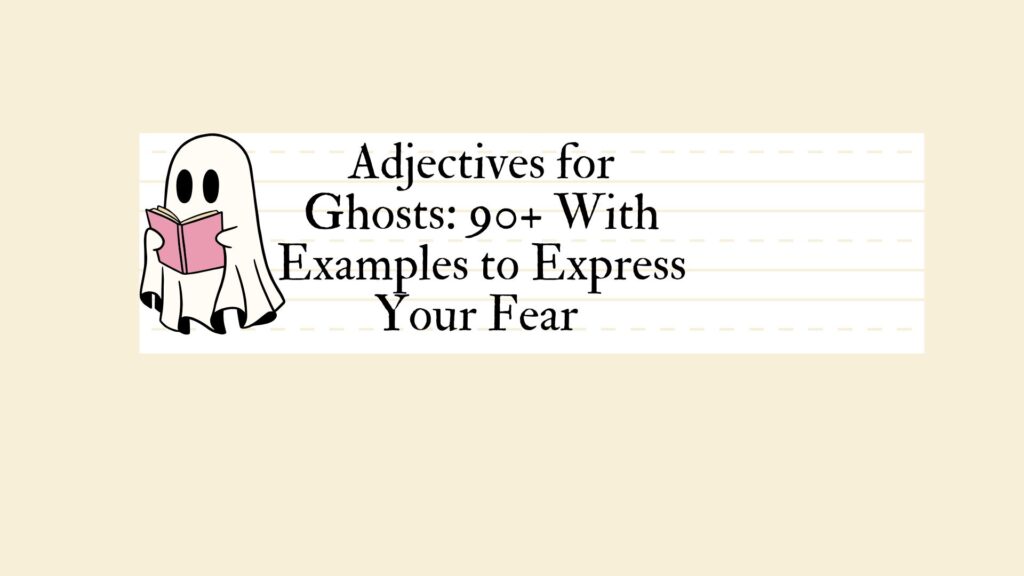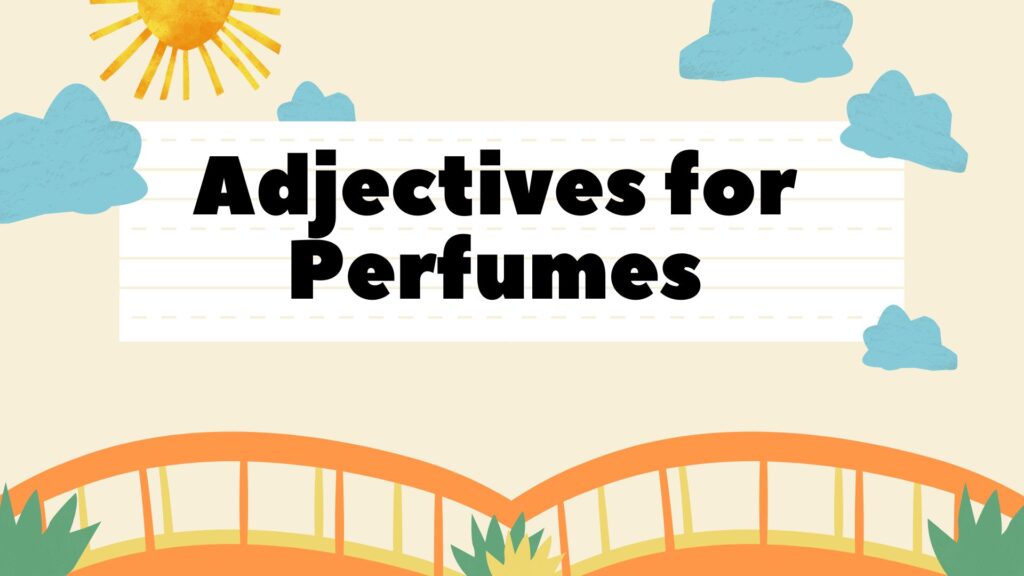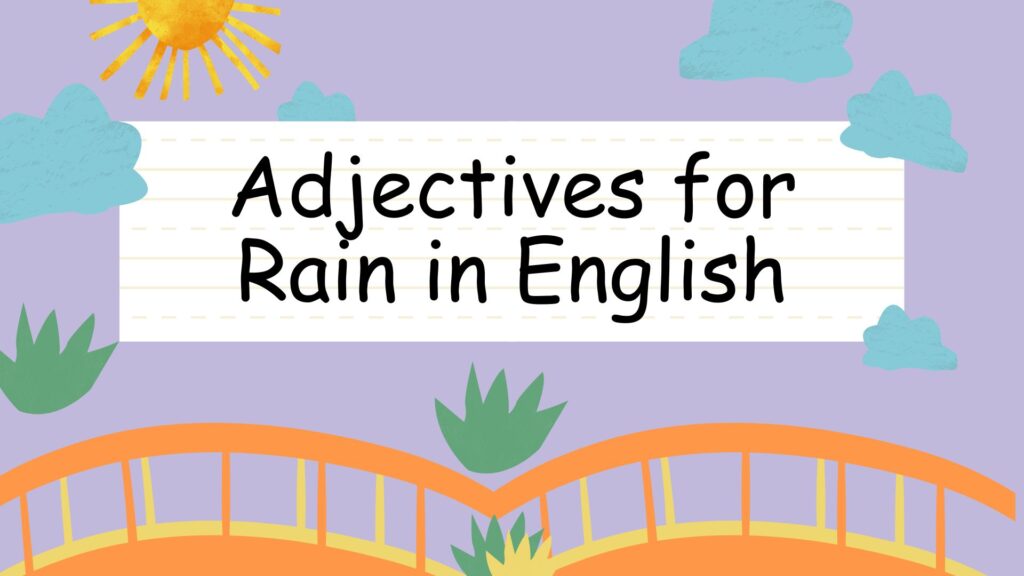Understanding how to use adjectives to describe ghosts can significantly enhance your writing, whether you’re crafting spooky stories, analyzing classic literature, or simply enriching your vocabulary. Adjectives add depth and specificity, allowing you to paint a vivid picture of these spectral beings. This article explores a wide array of adjectives suitable for describing ghosts, providing definitions, examples, usage rules, and practice exercises to help you master this aspect of English grammar. This guide is perfect for writers, students, and English language learners looking to add nuance and precision to their descriptions of the supernatural.
By the end of this article, you’ll not only have a comprehensive list of adjectives to describe ghosts but also a solid understanding of how to use them effectively in different contexts. Whether you’re aiming for eerie, humorous, or tragic portrayals, mastering these descriptive words will elevate your storytelling and communication skills.
Table of Contents
- Definition of Adjectives for Ghosts
- Structural Breakdown: Adjective Placement
- Types and Categories of Adjectives for Ghosts
- Examples of Adjectives for Ghosts
- Usage Rules for Adjectives Describing Ghosts
- Common Mistakes When Using Adjectives for Ghosts
- Practice Exercises
- Advanced Topics: Figurative Language and Adjectives
- Frequently Asked Questions
- Conclusion
Definition of Adjectives for Ghosts
Adjectives are words that describe or modify nouns, providing more information about their qualities or characteristics. When used to describe ghosts, adjectives help us visualize and understand these entities more clearly. They can specify a ghost’s appearance, behavior, emotional state, origin, or the effect it has on the living. The skillful use of adjectives can transform a generic “ghost” into a unique and compelling character.
In essence, adjectives for ghosts function just like any other adjective: they add detail and nuance to the noun they modify. The context in which these adjectives are used significantly impacts the reader’s interpretation. For example, describing a ghost as “vengeful” creates a very different impression than describing it as “melancholy.” Understanding the connotations of different adjectives is crucial for effective writing.
Adjectives can be classified based on their function. Descriptive adjectives (also known as qualitative adjectives) directly state a quality of the ghost, such as “transparent” or “eerie.” Limiting adjectives restrict the noun’s meaning in some way, such as “the only ghost” or “that ghost.” While descriptive adjectives are more common when describing ghosts, limiting adjectives can also be used to provide specific context.
Structural Breakdown: Adjective Placement
The typical placement of adjectives in English is before the noun they modify. This is known as the attributive position. For example, “the spectral figure” or “a haunted house.” However, adjectives can also appear after linking verbs such as “is,” “are,” “was,” “were,” “seems,” and “becomes.” This is known as the predicative position. For example, “The ghost was menacing” or “The house seemed haunted.”
When multiple adjectives are used to describe a single ghost, they typically follow a specific order, although this order can be flexible depending on the desired emphasis and flow of the sentence. A generally accepted order is: opinion, size, age, shape, color, origin, material, and purpose. For example, “a terrifying, large, old, shadowy ghost.” While this strict order isn’t always necessary, it provides a useful guideline for crafting grammatically sound and aesthetically pleasing descriptions.
Coordinate adjectives, which are adjectives of equal rank describing the same aspect of the noun, are separated by commas or the word “and.” For example, “a sad, lonely ghost” or “a frightening and malevolent spirit.” Non-coordinate adjectives, which modify the noun differently, do not require commas. For example, “a small stone ghost.” The distinction between coordinate and non-coordinate adjectives is crucial for correct punctuation and clarity.
Types and Categories of Adjectives for Ghosts
Adjectives for ghosts can be categorized based on the aspects they describe. These categories include appearance, behavior, emotional state, origin or history, and the effect the ghost has on the living. Understanding these categories can help you choose the most appropriate and impactful adjectives for your descriptions.
Adjectives Describing Appearance
These adjectives focus on the physical characteristics or visual aspects of the ghost. They help the reader visualize the ghost’s form, color, and overall presence.
Examples include: transparent, translucent, shadowy, spectral, ethereal, wispy, pale, luminous, shimmering, indistinct, grotesque, decaying, skeletal, gaunt, veiled, amorphous, wraithlike, phantom, vaporous, diaphanous.
Adjectives Describing Behavior
These adjectives describe how the ghost acts or interacts with its environment and the living. They convey the ghost’s actions, movements, and habits.
Examples include: restless, haunting, lingering, menacing, mischievous, playful, vengeful, malevolent, benevolent, protective, watchful, silent, wailing, moaning, shrieking, lurking, stalking, drifting, floating, hovering.
Adjectives Describing Emotional State
These adjectives reveal the ghost’s feelings, mood, or emotional condition. They add depth and humanity (or lack thereof) to the spectral being.
Examples include: sad, lonely, sorrowful, melancholic, angry, bitter, resentful, tormented, peaceful, serene, joyful, nostalgic, regretful, fearful, desperate, confused, lost, yearning, heartbroken.
Adjectives Describing Origin or History
These adjectives relate to the ghost’s past, its life before death, or the circumstances surrounding its existence as a ghost. They provide context and backstory.
Examples include: ancient, historical, legendary, forgotten, cursed, tragic, untimely, murdered, betrayed, wronged, restless, haunted, ancestral, familial, colonial, Victorian, medieval, wartime, preternatural, otherworldly.
Adjectives Describing Effects on the Living
These adjectives describe how the ghost affects those who encounter it, whether emotionally, physically, or psychologically. They highlight the ghost’s impact on the mortal world.
Examples include: terrifying, chilling, unnerving, unsettling, disturbing, frightening, petrifying, paralyzing, hypnotic, mesmerizing, inspiring, comforting, protective, guiding, warning, ominous, foreboding, spectral, supernatural, preternatural.
Examples of Adjectives for Ghosts
The following tables provide numerous examples of adjectives used to describe ghosts, categorized by the types discussed above. Each example sentence illustrates how the adjective can be used effectively in context.
Appearance Examples
This table showcases adjectives that describe the physical appearance of ghosts, providing a vivid image of their form and presence.
| Adjective | Example Sentence |
|---|---|
| Transparent | The transparent ghost shimmered faintly in the moonlight. |
| Translucent | A translucent figure drifted through the walls of the ancient manor. |
| Shadowy | A shadowy apparition lurked in the corners of the attic. |
| Spectral | The spectral form of the woman glided across the ballroom floor. |
| Ethereal | An ethereal glow surrounded the ghost as it approached. |
| Wispy | The wispy remains of the spirit faded into the morning mist. |
| Pale | A pale and gaunt ghost peered from the depths of the well. |
| Luminous | The luminous apparition illuminated the dark hallway. |
| Shimmering | A shimmering ghost danced across the surface of the lake. |
| Indistinct | The indistinct outline of the ghost made it difficult to discern its features. |
| Grotesque | A grotesque specter haunted the abandoned asylum. |
| Decaying | The decaying corpse of the pirate captain returned to seek revenge. |
| Skeletal | A skeletal figure rattled its chains in the dungeon. |
| Gaunt | The gaunt ghost reached out with its bony fingers. |
| Veiled | A veiled woman wept silently in the graveyard. |
| Amorphous | An amorphous blob floated near the ceiling. |
| Wraithlike | The wraithlike figure caused everyone to shiver. |
| Phantom | A phantom ship was seen sailing on the waves. |
| Vaporous | The vaporous form was hardly noticeable. |
| Diaphanous | A diaphanous ghost floated through the room. |
| Incandescent | An incandescent spirit ascended into the night sky. |
| Glimmering | The glimmering form moved behind the curtains. |
| Faint | The faint image of the ghost appeared in the mirror. |
| Dim | A dim figure was seen walking through the forest. |
| Opaque | The opaque ghost blocked the doorway. |
| Solid | The solid ghost was able to move objects. |
| Ghostly | A ghostly figure stood by the window. |
| Apparitional | An apparitional hand reached out. |
| Phantomlike | The phantomlike figure disappeared. |
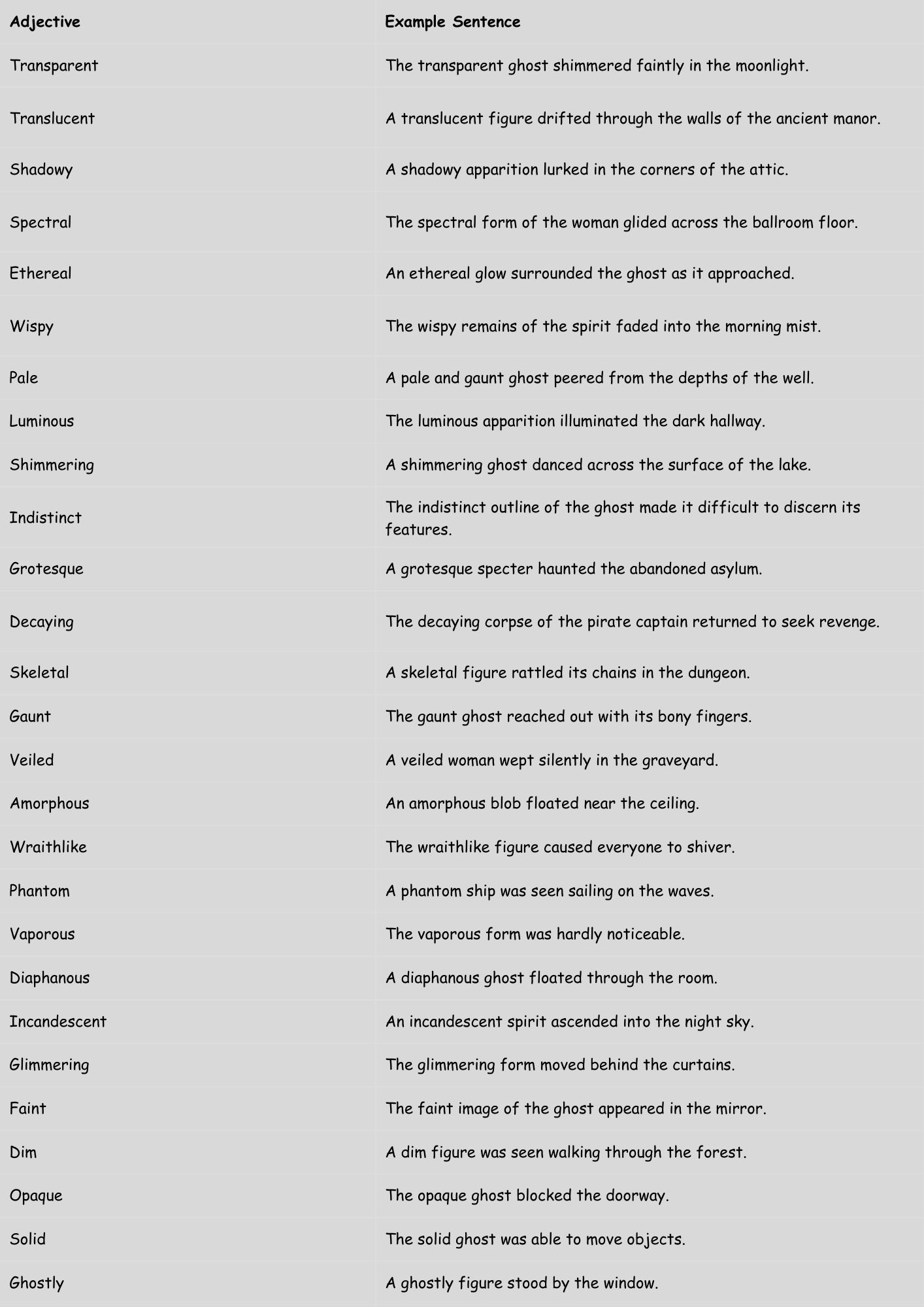
Behavior Examples
The following table illustrates adjectives describing the actions and behaviors of ghosts, creating a sense of their presence and interaction with the world.
| Adjective | Example Sentence |
|---|---|
| Restless | The restless spirit roamed the halls, unable to find peace. |
| Haunting | A haunting melody echoed through the abandoned theater. |
| Lingering | A lingering presence was felt in the room long after the ghost had vanished. |
| Menacing | The menacing ghost glared at anyone who dared to enter its domain. |
| Mischievous | A mischievous poltergeist delighted in rearranging furniture. |
| Playful | A playful spirit giggled as it tugged at the children’s blankets. |
| Vengeful | The vengeful ghost sought retribution for the wrongs committed against it. |
| Malevolent | A malevolent entity spread darkness and despair wherever it went. |
| Benevolent | A benevolent spirit watched over the family, protecting them from harm. |
| Protective | The protective ghost shielded the children from the evil that lurked in the shadows. |
| Watchful | A watchful guardian kept a silent vigil over the ancient tomb. |
| Silent | A silent observer stood in the corner. |
| Wailing | A wailing ghost cried out. |
| Moaning | A moaning spirit haunted the castle. |
| Shrieking | The shrieking ghost terrified the boy. |
| Lurking | A lurking figure haunted the alley. |
| Stalking | The stalking ghost was always behind them. |
| Drifting | A drifting figure floated by. |
| Floating | The floating ghost moved around the room. |
| Hovering | A hovering figure watched. |
| Roaming | The roaming spirit traveled across the land. |
| Prowling | A prowling ghost crept through the corridors. |
| Screaming | The screaming apparition echoed through the night. |
| Whispering | A whispering voice came from the shadows. |
| Crying | The crying ghost was sitting in the corner. |
| Laughing | A laughing ghost delighted in the chaos. |
| Singing | A singing ghost was heard in the forest. |
| Dancing | The dancing ghost moved around the room. |
| Chasing | A chasing spirit was seen running across the field. |
Emotional State Examples
This table provides examples of adjectives that describe the emotional state of ghosts, adding layers of depth and personality to these spectral beings.
| Adjective | Example Sentence |
|---|---|
| Sad | A sad ghost wept over its lost love. |
| Lonely | The lonely spirit wandered the earth, searching for companionship. |
| Sorrowful | A sorrowful specter mourned the loss of its family. |
| Melancholic | The melancholic phantom played a mournful tune on the piano. |
| Angry | An angry ghost lashed out at anyone who disturbed its rest. |
| Bitter | A bitter spirit resented the circumstances of its death. |
| Resentful | The resentful ghost harbored deep grudges against its enemies. |
| Tormented | A tormented soul writhed in eternal agony. |
| Peaceful | A peaceful spirit watched over its loved ones with contentment. |
| Serene | The serene ghost radiated a sense of calm and tranquility. |
| Joyful | A joyful apparition celebrated its newfound freedom. |
| Nostalgic | A nostalgic ghost remembered the past. |
| Regretful | A regretful spirit thought about what it could have done. |
| Fearful | The fearful ghost ran away. |
| Desperate | A desperate soul wanted attention. |
| Confused | A confused spirit was lost. |
| Lost | A lost ghost was never found. |
| Yearning | The yearning ghost wanted to be alive. |
| Heartbroken | A heartbroken soul never recovered. |
| Depressed | The depressed ghost sat in the corner. |
| Anxious | An anxious spirit was always worried. |
| Worried | The worried ghost was thinking of the future. |
| Hopeful | A hopeful spirit waited for the end. |
| Hopeless | The hopeless ghost lost faith. |
| Calm | The calm spirit was peaceful. |
| Excited | An excited ghost ran around. |
| Bored | The bored ghost had nothing to do. |
| Envious | An envious spirit was jealous of the living. |
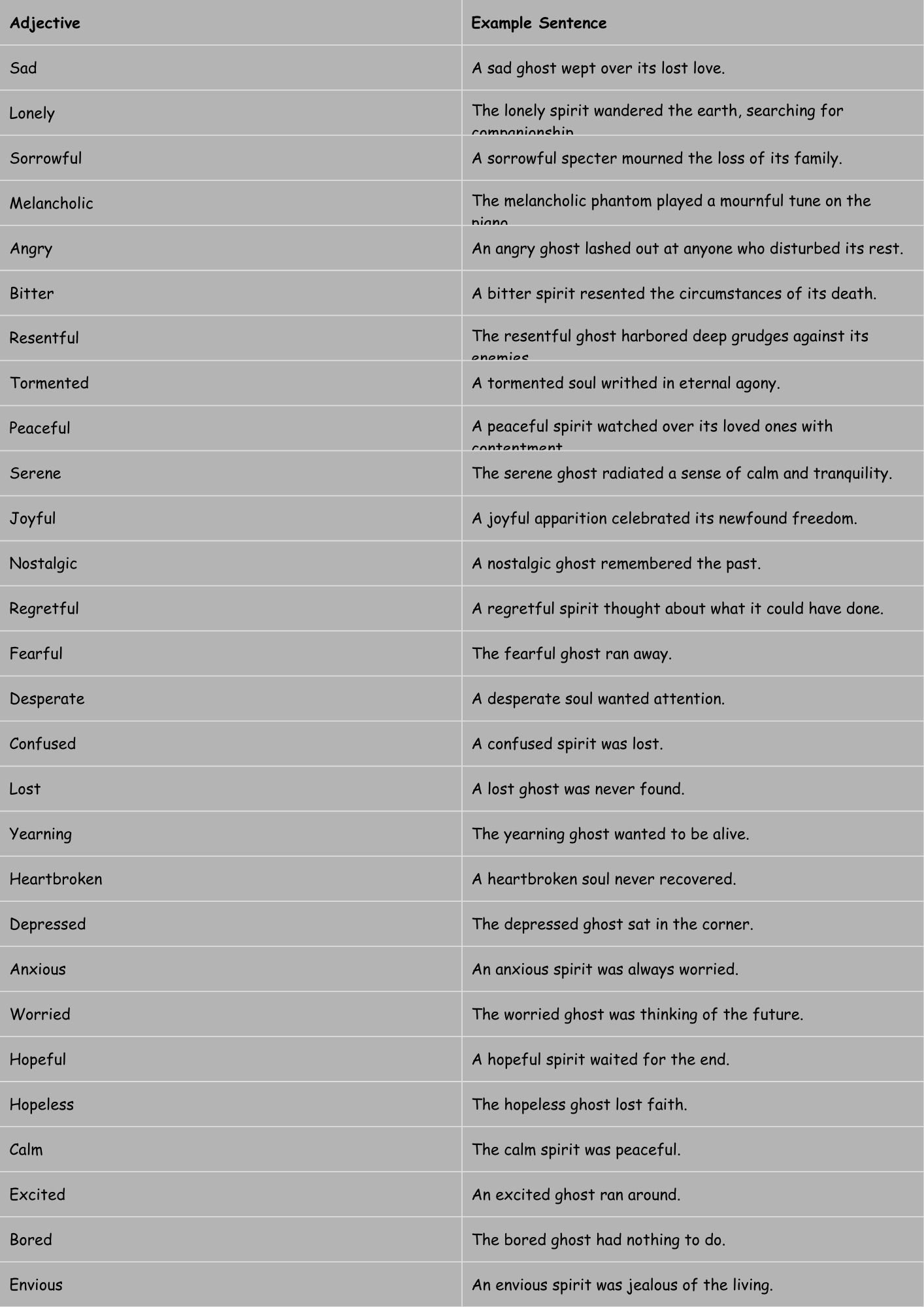
Origin Examples
This table presents adjectives that describe the origin or history of ghosts, providing context to their spectral existence.
| Adjective | Example Sentence |
|---|---|
| Ancient | An ancient spirit has been around for a long time. |
| Historical | The historical ghost was an important person. |
| Legendary | A legendary ghost haunted the castle. |
| Forgotten | The forgotten spirit was no longer remembered. |
| Cursed | A cursed ghost was doomed to wander. |
| Tragic | A tragic spirit was a victim. |
| Untimely | An untimely ghost died young. |
| Murdered | A murdered ghost sought vengeance. |
| Betrayed | The betrayed spirit was angry. |
| Wronged | A wronged spirit wanted justice. |
| Restless | The restless spirit was uneasy. |
| Haunted | A haunted ghost had dark memories. |
| Ancestral | The ancestral spirit was a family member. |
| Familial | A familial ghost protected them. |
| Colonial | The colonial spirit lived long ago. |
| Victorian | A Victorian ghost wore old clothes. |
| Medieval | The medieval ghost had been a knight. |
| Wartime | A wartime spirit died in battle. |
| Preternatural | The preternatural ghost was strange. |
| Otherworldly | An otherworldly presence filled the room. |
| Ancient Roman | The ancient Roman ghost lamented the fall of the empire. |
| Elizabethan | The Elizabethan ghost recited Shakespearean sonnets. |
| Feudal | The feudal ghost mourned his lost lands. |
| Revolutionary | The revolutionary ghost still fought for freedom. |
| Civil War | The Civil War ghost wandered the battlefield. |
| Gangster-era | The gangster-era ghost haunted the speakeasy. |
| World War II | The World War II ghost remembered the war. |
| Roaring Twenties | The Roaring Twenties ghost danced the Charleston. |
Effect Examples
This table provides examples of adjectives that describe the effects ghosts have on the living, creating a sense of fear, awe, or other reactions.
| Adjective | Example Sentence |
|---|---|
| Terrifying | A terrifying ghost made everyone scream. |
| Chilling | The chilling ghost sent shivers down their spines. |
| Unnerving | The unnerving ghost made them uneasy. |
| Unsettling | An unsettling spirit made them nervous. |
| Disturbing | A disturbing ghost caused sleepless nights. |
| Frightening | The frightening ghost was very scary. |
| Petrifying | A petrifying ghost turned them to stone. |
| Paralyzing | The paralyzing ghost stopped them in their tracks. |
| Hypnotic | A hypnotic ghost controlled their minds. |
| Mesmerizing | The mesmerizing ghost captivated them. |
| Inspiring | An inspiring spirit gave them hope. |
| Comforting | The comforting ghost made them feel safe. |
| Protective | A protective spirit kept them safe. |
| Guiding | A guiding ghost led them down the right path. |
| Warning | The warning spirit told them of danger. |
| Ominous | An ominous spirit foretold disaster. |
| Foreboding | The foreboding ghost made them scared. |
| Spectral | The spectral presence was eerie. |
| Supernatural | A supernatural spirit appeared. |
| Preternatural | The preternatural force was beyond understanding. |
| Awe-inspiring | The awe-inspiring apparition left everyone speechless. |
| Soul-stirring | The soul-stirring encounter left a lasting impact. |
| Mind-bending | The mind-bending experience challenged their perceptions. |
| Heart-wrenching | The heart-wrenching tale of the ghost moved them to tears. |
| Bone-chilling | The bone-chilling presence made them tremble. |
| Hair-raising | The hair-raising story kept them awake at night. |
| Spine-tingling | The spine-tingling sensation made their skin crawl. |
| Eerie | The eerie silence was broken by a sudden gust of wind. |
Usage Rules for Adjectives Describing Ghosts
Several rules govern the proper use of adjectives when describing ghosts. First, ensure that the adjective accurately reflects the intended meaning. Consider the connotations of the adjective and how it contributes to the overall portrayal of the ghost. For example, using “ghastly” implies a horrific and repulsive appearance, while “ethereal” suggests a delicate and otherworldly beauty.
Pay attention to the order of adjectives when using multiple adjectives. While the general order (opinion, size, age, shape, color, origin, material, purpose) provides a guideline, prioritize clarity and flow. Avoid overloading the noun with too many adjectives, as this can make the sentence cumbersome and difficult to read. Choose the most impactful adjectives to convey the desired image.
Be mindful of using adjectives that create contradictory or nonsensical descriptions. For instance, describing a ghost as “solid and transparent” presents a logical inconsistency. Ensure that the adjectives you choose are compatible and contribute to a coherent image of the ghost.
Adjectives can also be intensified using adverbs. For example, “very frightening” or “incredibly sad.” However, avoid overusing intensifiers, as they can weaken the impact of the adjective. Choose strong adjectives that convey the desired intensity without the need for excessive adverbs.
Common Mistakes When Using Adjectives for Ghosts
One common mistake is using adjectives that are too general or vague. For example, describing a ghost simply as “scary” lacks specificity. Instead, opt for more descriptive adjectives like “terrifying,” “chilling,” or “unnerving” to create a stronger impression.
Another frequent error is misusing adjectives that sound similar but have different meanings. For example, “spectral” and “spectacular” are easily confused. “Spectral” refers to something ghostly or related to a specter, while “spectacular” means impressive or dramatic. Using the wrong adjective can completely alter the intended meaning.
Incorrect adjective placement is also a common mistake. Remember that adjectives typically precede the noun they modify (attributive position) or follow a linking verb (predicative position). Avoid placing adjectives in awkward or grammatically incorrect positions within the sentence.
Overusing adjectives can also detract from the writing. While adjectives add detail, too many can make the writing feel cluttered and overwhelming. Choose adjectives judiciously, focusing on the ones that provide the most significant impact and contribute to the overall image of the ghost.
Here are some examples of common mistakes and their corrections:
| Incorrect | Correct | Explanation |
|---|---|---|
| The ghost was scary. | The ghost was terrifying. | “Terrifying” is more specific and impactful than “scary.” |
| A spectacular ghost appeared. | A spectral ghost appeared. | “Spectral” refers to something ghostly, while “spectacular” means impressive. |
| The house haunted ghost. | The haunted house. | Adjectives typically precede the noun they modify. |
| The ghost, very, very, very sad. | The very sad ghost. | Avoid overusing intensifiers. |
Practice Exercises
Test your understanding of adjectives for ghosts with the following exercises. Choose the most appropriate adjective from the options provided to complete each sentence.
Exercise 1: Identifying Appropriate Adjectives
| Question | Options | Answer |
|---|---|---|
| The ______ ghost floated through the castle halls. | a) happy, b) transparent, c) delicious | b) transparent |
| A ______ wail echoed through the graveyard. | a) silent, b) wailing, c) colorful | b) wailing |
| The ______ spirit sought revenge on its murderers. | a) benevolent, b) vengeful, c) playful | b) vengeful |
| An ______ presence filled the room, making the temperature drop. | a) comfortable, b) unnerving, c) amusing | b) unnerving |
| The ______ ghost seemed to glow with an inner light. | a) pale, b) luminous, c) dark | b) luminous |
| The ______ figure disappeared into the shadows. | a) solid, b) shadowy, c) bright | b) shadowy |
| A ______ spirit watched over the sleeping child. | a) malevolent, b) protective, c) indifferent | b) protective |
| The ______ ghost was trapped between worlds. | a) joyful, b) tormented, c) serene | b) tormented |
| The ______ apparition faded into the mist. | a) concrete, b) ethereal, c) heavy | b) ethereal |
| A ______ atmosphere pervaded the old house. | a) cheerful, b) ominous, c) lively | b) ominous |
Exercise 2: Using Adjectives in Sentences
Write a sentence using each of the following adjectives to describe a ghost:
- Restless
- Melancholic
- Grotesque
- Forgotten
- Chilling
Possible answers:
- The restless ghost paced the floorboards, unable to find peace.
- A melancholic spirit played a sad song on the dusty piano.
- The grotesque specter terrified all who saw it.
- The forgotten ghost drifted aimlessly, its name lost to time.
- A chilling presence emanated from the spectral figure.
Exercise 3: Correcting Incorrect Adjective Usage
Identify and correct the incorrect adjective usage in the following sentences:
| Incorrect Sentence | Corrected Sentence | Explanation |
|---|---|---|
| The ghost was very spectacularly. | The ghost was very spectral. | “Spectacularly” is an adverb, not an adjective. “Spectral” is the correct adjective to describe a ghost. |
| A happy ghost haunted the castle. | A haunting ghost haunted the castle. | “Happy” doesn’t fit the context of a haunting. “Haunting” is more appropriate. |
| The solid and transparent ghost appeared. | The translucent ghost appeared. | “Solid” and “transparent” are contradictory. “Translucent” is a better fit. |
| The ghost was a delicious sight. | The ghost was a disturbing sight. | “Delicious” is not appropriate for describing a ghost. “Disturbing” is more fitting. |
| The silent loud ghost echoed. | The silent ghost echoed. | “Loud” contradicts “silent.” Removing “loud” makes the sentence coherent. |
Advanced Topics: Figurative Language and Adjectives
Advanced learners can explore the use of adjectives in figurative language to create more nuanced and evocative descriptions of ghosts. Metaphors and similes, in particular, can be enhanced by carefully chosen adjectives.
For example, instead of simply saying “The ghost was sad,” you could use a metaphor: “The ghost’s sorrow was a heavy cloak, weighing it down.” The adjective “heavy” adds depth to the metaphor, conveying the intensity of the ghost’
s sorrow.
Similarly, similes can be enriched with adjectives. Instead of “The ghost moved like smoke,” try “The ghost moved like ethereal smoke, wisps of its form dissolving into the air.” The adjective “ethereal” reinforces the ghostly quality, while “wisps” adds a visual element that enhances the simile.
Personification, another form of figurative language, can also benefit from descriptive adjectives. For example, “The wind whispered secrets” becomes “The mournful wind whispered forgotten secrets,” giving the wind a distinct emotional tone and historical context. These techniques elevate the writing, making it more engaging and memorable.
Consider using synesthesia, a technique that blends senses, to create unique and striking descriptions. For instance, “a cold voice” is a common synesthetic expression. When describing ghosts, you could say “The ghost had a bitter silence,” combining the senses of taste and hearing to create a haunting image. Experiment with different sensory combinations to find what works best for your writing style.
Frequently Asked Questions
- Q: Can I use any adjective to describe a ghost?
- While creativity is encouraged, it’s important to choose adjectives that logically and contextually fit the description of a ghost. Ensure the adjective enhances the reader’s understanding and doesn’t create a contradictory or nonsensical image.
- Q: How many adjectives should I use to describe a ghost?
- There’s no strict limit, but it’s generally best to use only as many adjectives as necessary to convey the desired image. Overloading the noun with too many adjectives can make the writing feel cluttered. Prioritize quality over quantity.
- Q: What if I can’t think of the perfect adjective?
- Use a thesaurus to explore synonyms and related words. Consider the specific qualities you want to emphasize and look for adjectives that capture those nuances. Sometimes, a slightly different word can make a significant difference.
- Q: Are there any adjectives I should avoid when describing ghosts?
- Avoid adjectives that are overly generic or cliché, such as “scary” or “creepy.” Opt for more specific and evocative words that paint a vivid picture. Also, avoid adjectives that create logical inconsistencies or contradict the established context.
- Q: Can I create my own adjectives to describe ghosts?
- While it’s possible to create new words (neologisms), use caution. Ensure that the new adjective is easily understood and fits seamlessly into the sentence. Overusing made-up words can detract from the writing, so use them sparingly and purposefully.
Conclusion
Mastering the use of adjectives to describe ghosts can significantly enhance your writing, adding depth, nuance, and vivid imagery to your spectral portrayals. By understanding the different categories of adjectives – appearance, behavior, emotional state, origin, and effect – and following the rules of usage, you can create compelling and memorable descriptions of these supernatural entities.
Remember to choose adjectives that accurately reflect the intended meaning, pay attention to adjective order, and avoid common mistakes such as overuse or logical inconsistencies. Experiment with figurative language and advanced techniques to elevate your writing and create truly haunting and evocative descriptions.
With practice and attention to detail, you can wield adjectives with skill and precision, transforming a generic “ghost” into a unique and unforgettable character. Whether you’re writing spooky stories, analyzing classic literature, or simply enriching your vocabulary, the power of descriptive language will serve you well.

